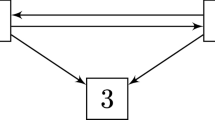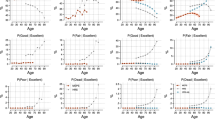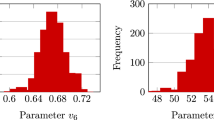Abstract
We focus on the evaluation of the long-term health care services provided to elderly patients by nursing homes of four different health districts in the Umbria region (Italy). To this end, we analyze data coming from a longitudinal survey aimed at assessing several aspects of patient health conditions and develop an extended version of the latent Markov model with covariates, which allows us to deal with dropout and intermittent missing data patterns that are common in longitudinal studies. Maximum likelihood estimates are obtained by a two-step approach that allows for fast estimation of model parameters and prevents some drawbacks of the standard maximum likelihood method encountered in the presence of many response variables and covariates. In the application to the observed data, we show how to obtain indicators of the effectiveness of the health care services delivered by each health district, by means of a resampling procedure.
Similar content being viewed by others
References
Akaike H (1973) Information theory and an extension of the maximum likelihood principle. In: Petrov B, Csaki F (eds) Second international symposium on information theory. Akademiai Kiado, Budapest
Allman ES, Matias C, Rhodes JA (2009) Identifiability of parameters in latent structure models with many observed variables. Ann Stat 37:3099–3132
Bacci S, Pandolfi S, Pennoni F (2014) A comparison of some criteria for states selection in the latent Markov model for longitudinal data. Adv Data Anal Classif 8:125–145
Bartolucci F, Lupparelli M, Montanari GE (2009) Latent Markov model for binary longitudinal data: an application to the performance evaluation of nursing homes. Ann Appl Stat 3:611–636
Bartolucci F, Farcomeni A, Pennoni F (2013) Latent Markov models for longitudinal data. Chapman and Hall/CRC Press, Boca Raton
Bartolucci F, Montanari G, Pandolfi S (2014) A comparison of some estimation methods for latent Markov models with covariates. In: Proceedings of COMPSTAT 2014—21st international conference on computational statistics, pp 531–538
Bartolucci F, Montanari GE, Pandolfi S (2015) Three-step estimation of latent Markov models with covariates. Comput Stat Data Anal 83:287–301
Baum L, Petrie T, Soules G, Weiss N (1970) A maximization technique occurring in the statistical analysis of probabilistic functions of Markov chains. Ann Math Stat 41:164–171
Collins L, Lanza S (2009) Latent class and latent transition analysis: with applications in the social, behavioral, and health sciences. Wiley, Wiley series in probability and statistics
Dempster AP, Laird NM, Rubin DB (1977) Maximum Likelihood from incomplete data via the EM algorithm. J Roy Stat Soc B 39:1–38
Di Mari R, Oberski DL, Vermunt JK (2016) Bias-adjusted three-step latent markov modeling with covariates. Struct Equ Modeling 23:649–660
Goodman L (1974) Exploratory latent structure analysis using both identifiable and unidentifiable models. Biometrika 61:215–231
Lazarsfeld PF (1950) The logical and mathematical foundation of latent structure analysis. In: Stouffer SA, Guttman EASL (eds) Measurement and prediction. Princeton University Press, New York
Lazarsfeld PF, Henry NW (1968) Latent structure analysis. Houghton Mifflin, Boston
Little R, Rubin D (2002) Statistical analysis with missing data, 2nd edn. Wiley, New York
Rubin DB (1976) Inference and missing data. Biometrika 63:581–592
Schwarz G (1978) Estimating the dimension of a model. Ann Stat 6:461–464
Vermunt J, Magidson J (2005) Factor analysis with categorical indicators: a comparison between traditional and latent class approaches. In: Van der Ark L, Croon M, Sijtsma K (eds) New developments in categorical data analysis for the social and behavioral sciences. Psychology Press, London
Wiggins L (1973) Panel analysis: latent probability models for attitude and behaviours processes. Elsevier, Amsterdam
Acknowledgements
All authors acknowledge the financial support from Regione Umbria (IT).
Author information
Authors and Affiliations
Corresponding author
Appendix
Appendix
We report here the list of items composing each section of the questionnaire used for the LTCF dataset (Table 9).
Rights and permissions
About this article
Cite this article
Montanari, G.E., Pandolfi, S. Evaluation of long-term health care services through a latent Markov model with covariates. Stat Methods Appl 27, 151–173 (2018). https://doi.org/10.1007/s10260-017-0390-2
Accepted:
Published:
Issue Date:
DOI: https://doi.org/10.1007/s10260-017-0390-2




